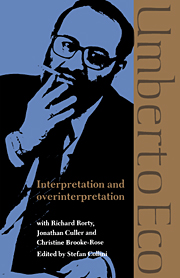2 - Overinterpreting texts
Published online by Cambridge University Press: 03 February 2010
Summary
In ‘Interpretation and history’ I looked at a method of interpreting the world and texts based on the individuation of the relationships of sympathy that link microcosm and macrocosm to one another. Both a metaphysic and a physic of universal sympathy must stand upon a semiotics (explicit or implicit) of similarity. Michel Foucault has already dealt with the paradigm of similarity in Les mots et les choses, but there he was principally concerned with that threshold moment between the Renaissance and the seventeenth century in which the paradigm of similarity dissolves into the paradigm of modern science. My hypothesis is historically more comprehensive and is intended to highlight an interpretive criterion (which I call Hermetic semiosis) the survival of which can be traced through the centuries.
In order to assume that the similar can act upon the similar, the Hermetic semiosis had to decide what similarity was. But its criterion of similarity displayed an over-indulgent generality and flexibility. It included not only those phenomena that today we would list under the heading of morphological resemblance or proportional analogy, but every kind of possible substitution permitted by the rhetoric tradition, that is, contiguity, pars pro toto, action or actor, and so on and so forth.
I have drawn the following list of criteria for associating images or words not from a treatise on magic but from a sixteenth-century mnemonics or ars memoriae. The quotation is interesting because – quite apart from any Hermetic presumption – the author has identified in the context of his own culture a number of associative automatisms commonly accepted as effective.
- Type
- Chapter
- Information
- Interpretation and Overinterpretation , pp. 45 - 66Publisher: Cambridge University PressPrint publication year: 1992
- 28
- Cited by



